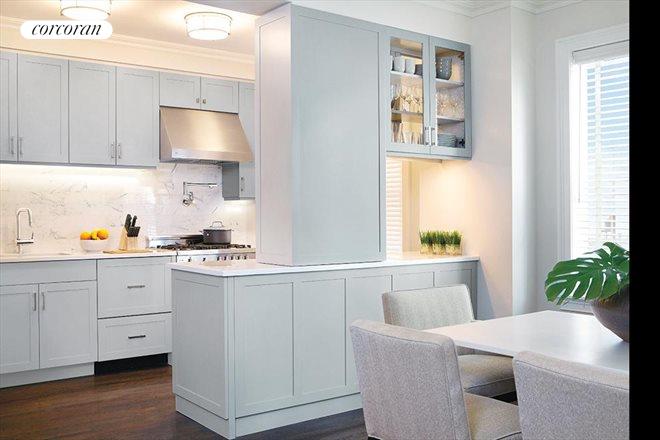“Pre-War,” as in Pre-World War II, is a term loaded with meaning for buyers in New York City.
For some it implies a grace of layout.
For others, thick walls, better closets, larger baths, bigger kitchens, more detail.
Pre-war predates the the low ceilinged, “cookie cutter” layout that is certainly present in much of the construction from 1965-1995.
This range of time could be expanded or contracted, but in truth, there is a perception that buildings of the Pre-war vintage rise above their post-war peers (pun intended).
Today, buyers have interests that conflict with the designs of the 1920’s and early 1930’s.
The open kitchen plan is in direct opposition to the layouts in Prewar apartments, for the most part.
Kitchen were once tucked away out of view, often with the worst views of an apartment.
Now that buyers want their kitchens to be part of the entertaining space, apartments must be reconfigured, wherever possible, to accommodate.
Removing walls, pushing kitchens further into the living space, taking over maid’s rooms (often behind kitchens), bringing in as much light as possible are but a few changes among many that can update an apartment layout.
Modern conveniences also seem to butt against Pre-war construction.
Often, central air-conditioning cannot be put through the wall in a Pre-war apartment, either due to Landmark considerations or simply building’s rules.
Vents which actually pull air out of a building for cooking are key when a kitchen doesn’t have
a window, or where the airflow keeps kitchen smells in an apartment.
Therefore, a pre-war apartment that has overcome much of the potential shortcomings becomes that much more coveted by NYC buyers.
Or, conversely, a new construction that incorporates the best of Pre-war and modern convenience proves to be a winner.
This may be dismaying to architects out there.
What the public seems to be saying is that they like the old better than the new.
Perhaps, though, the real sentiment is that what we know is better than what we don’t know.
Significant architects like Robert Stern have made a terrific living creating new that looks like old, for instance.
15 Central Park West is among the most successful developments in the history of New York.
One57, on the other hand, incorporated timeless design which is meant to bridge the gap.
With that in mind, I visited two properties this month that are on the market and both seem to have today’s buyer in mind.
The Mirabeau, which is at the corner of 91st street and Amsterdam, is a Pre-war rental building being converted to condominium.
The Charles, a new development at 73rd and First Avenue, is a 31-story new construction aimed to re-create the grace of the old in a new envelope.
The Mirabeau is positioned on the Northeast corner of 91st street and Amsterdam.
Before we go further into the location, let’s talk about the properties.
165 West 91st is the latest conversion development by Urban American.
Given the number of conversions they have done, including 215 w 88th, among others, they’ve had some time to perfect the transition to condominiums, and gotten “Big Data” on what buyers are looking for.
They have created open kitchens with lovely pass-thru islands, terrific finishes that bridge the contemporary and traditional, otherwise known as “transitional.”
Overhead glass-fronted cabinets above these islands maximizes light from front to back.
Central HVAC has been installed, which makes a cooler apartment also a quieter experience, in comparison to the thru-window, super-loud air condition.
Not to mention that aesthetically, central air is superior even to thru-wall in that it takes up less space and is essentially invisible.
Further, the developer has combined apartments in creating large layouts.
In doing so, closets have been maximized, and master bedrooms with en-suite baths have been done very well.
Ceilings are high, the new floors are gorgeous, and the general detail either retained or brought in keeps the sense of the Pre-war.
Having fewer apartments in a full-service building might make the monthly charges a touch higher, but it lends a boutique feel at the same time- also preferred by today’s buyer.
While secondary bedrooms seem to be a bit on the small side, I am sure that the focus was to create large living spaces, as large as possible, separating the living from the bedrooms.
The finishes are nice, but I have some concern that the secondary baths were not given enough detail.
Granted, a developer has to keep cost in check, so I understand where they may have decided to put their focus.
But, at $1500-1900 per square foot, they seem to have delivered large enough units at the right price- they are selling everything that they bring to market.
Worth a visit!
All I will add is some discussion of location.
My view on the Upper West Side is that the biggest change above and below 86th is the retail available.
The retail, especially above 96th street, lacks much of the diversity of boutiques, high-end shopping that one sees in the 60’s, 70’s and 80’s.
Otherwise, the buildings and block-by-block considerations are pretty personal for buyers;
there are “bad blocks” across the Upper West Side and Morningside Heights, and incredibly charming blocks as well.
That said,
the location may end up being a concern for many buyers here.
Amsterdam can be a bit of a noisy road, as it is a truck thru-way.
Also, it is across the street from what may become a tall building.
The funeral home on the Southwest corner continues to be an interesting opportunity for a developer.
Currently 3 stories, it could very well become a new construction.
In fact, I have heard some rumors, but nothing more right now!
I’ll write about The Charles in my next post.

